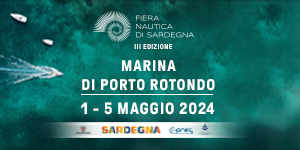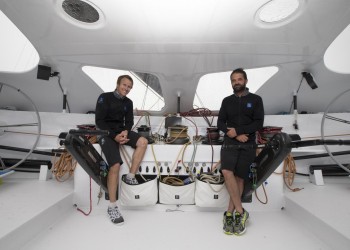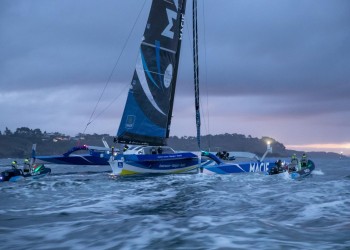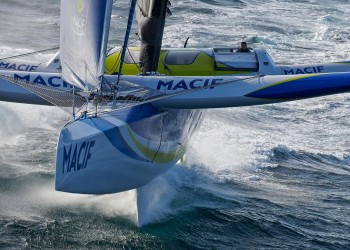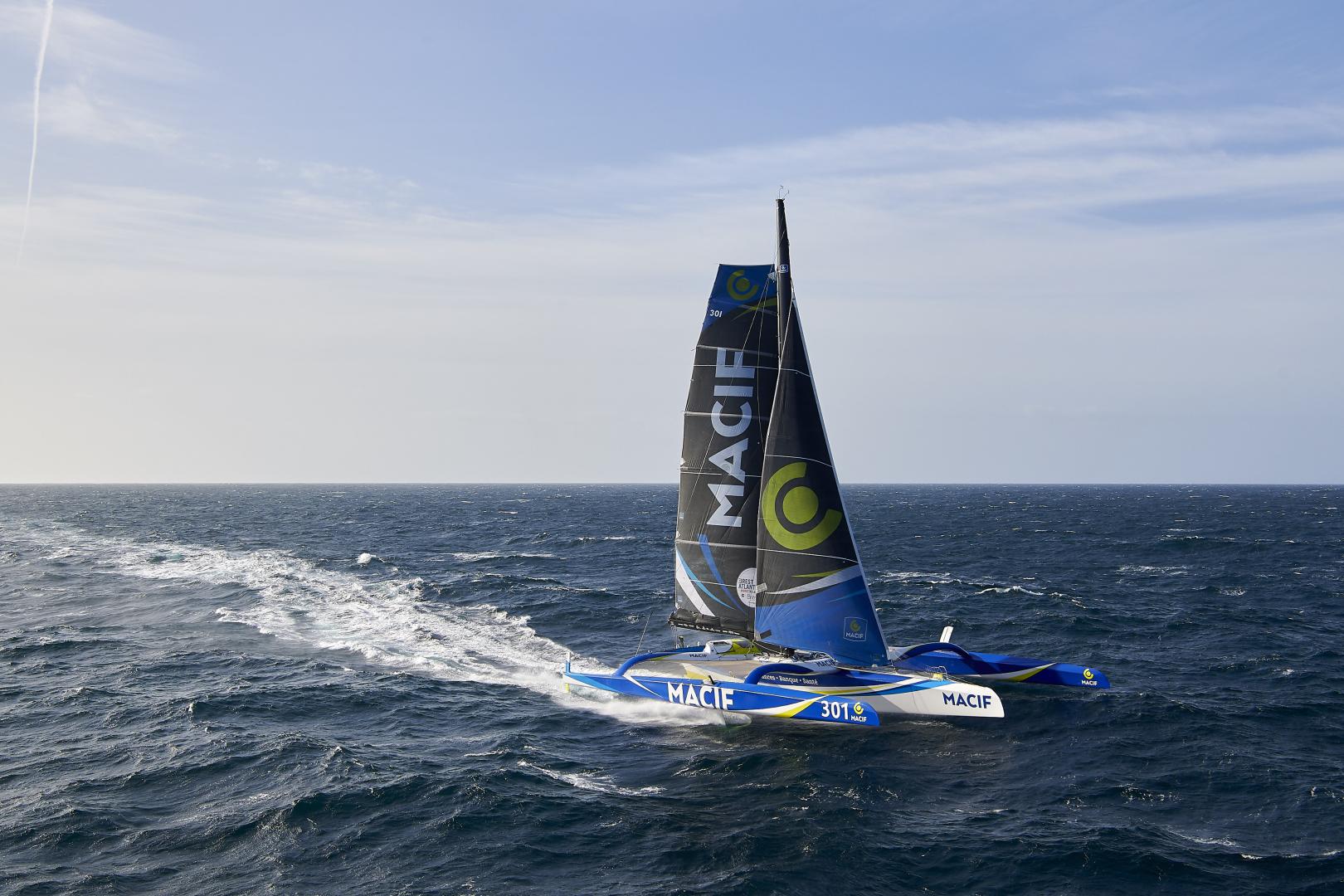
MACIF trimaran, a quick rundown on the Brest Atlantiques
MACIF trimaran, a quick rundown on the Brest Atlantiques
The Crew
The Brest Atlantiques is raced double handed, but there will be three crew members on board. Apart from the skipper, François Gabart and his co-skipper Gwénolé Gahinet, the MACIF trimaran will also have a media man. Jérémie Eloy, ex-professional kite surfer has retrained to become the image expert. His role will be to tell us, through images, about the race and life aboard the MACIF trimaran, as well the men’s story being played out in the Atlantic Ocean, without ever sailing himself.
Holder of the Jules Verne Trophy on Francis Joyon’s trimaran since 2016, Gwénolé Gahinet it is one of the few young men in his thirties capable of taking control of a 30-metre trimaran. Although François Gabart did not know him very well when he offered him the job of accompanying him across the Atlantic, they had little trouble getting on well. “We seem to naturally hit it off,” says François Gabart, the single-handed round the world record holder. We share the same mindset and the same desire to enjoy performance, with an ability to question ourselves.”
The MACIF Trimaran
The MACIF trimaran was launched in 2015, and complies with the Ultim 32/23 class measurement rules. It measures 30 metres, with a beam of 21 metres and a draught of 25 metres. It is equipped with foils, a centreboard and two T-shaped rudders. It boasts an additional “cabin” living area aft of the closed cockpit, which gives the skippers a dry, enclosed space where they can sail safely.
> This Year’s Optimisations
The MACIF trimaran spent some time at the boatyard last winter, with the aim of making her more reliable. Some of the sea giants suffered a considerably during the Route du Rhum in 2018, with the result that the Ultim class teams shared their technological feedback to help improve the whole of the fleet. So, the MACIF racing team strengthened the trimaran’s front crossbeams and changed the appendage systems – a foil had “broken away” in the first days of the Route du Rhum – and the foils’ trim and position foiling. The MACIF trimaran is now flat when it is airborne, with its nose slightly lower. Aerodynamic features were added and new foils built to improve performance.
> Performance
Although the MACIF trimaran is not the most recent Ultim, her performance has been astonishing, with each trip to sea adding a new batch of improvements. “The MACIF trimaran one of the older members of the fleet for the first time,” says François Gabart. “Yet she is not all that old and still performs really well. We know her inside out and yet we learn things every day. She sailed round the world (single-handed) in 42 days and there is still plenty of potential for improvement. MACIF is easy to sail because she is one of the lightest boats in the fleet. All you need is a little canvas to sail fast.”
> Foiling
With foils and T-shaped rudders, the MACIF trimaran can lift above the sea and remain airborne for increasingly long periods. “We are lucky to be pioneers in the history of offshore racing. This revolution has an impact on the entire boating industry, from the smallest to the largest boats. The things we are inventing today will be used by all of us in the future. And, as with all technological revolutions, we make mistakes, we try again and we succeed. When we refer to “flying” this is a misconception,” says her skipper, “since we remain in contact with the water”. The trimarans’ goal is to make foiling more frequent, and easier over longer periods. We cannot sail around the world on foils, but we can remain airborne for a considerable length of time. The challenge is to maintain the boat on foils for as long as possible with the least effort.”
>Something Special Aboard
On the Initiative of Gwénolé Gahinet, who strongly advocates sustainable development, the MACIF trimaran will be a testing ground for a few low-tech experiments. “Low-tech is directly linked to our relationship with nature and to the necessary changes in our way of life,” explains the MACIF trimaran co-skipper. We will grow mushrooms and sprouting seeds on board – wonderful for improving the quality of food on board. You will discover the rest during the race!
The Course
The course is a 14,000-mile figure of eight that runs from the north of the Atlantic to the south and back. From Brest, the four Ultim 32/23 trimarans will sail 5,000 miles south to Brazil, in the direction of the Bay of Rio de Janeiro, leaving a course mark to port in the Cagarras Archipelago. Immediately afterwards, the trimarans will sail 3,250 miles from west to east to Cape Town. They will have to run round a second course Mark at Robben Island, which is famous for being the Island where Nelson Mandela was imprisoned for 27 years. To do this, the contenders, including the MACIF trimaran sailors may choose a very southerly route into the cold waters of the Roaring Forties. After Robin Island, they will head back to Brest, by any possible route.
François Gabart: “It’s one hell of a course! The Brest Atlantiques will take us to places on the globe we are not used to sailing in, particularly in the northeast part of the South Atlantic. It looks as though we will spend just under a month at sea sailing this triangle, which, in the end, is only a little shorter than a round the world by the three capes. The first part is fairly standard and then we will sail round St Helena Island from the North, before sailing downwind from the Cape to the equator. The sail back up the Atlantic will be a classic of its kind. In the end, I think we will spend more time optimising our course and speed with velocity made good (VMG)”.
What François Gabart Had to Say Before the Start
Following the briefing this Monday morning, confirming the start at 11 am on Tuesday, François Gabart said: “The weather will be heavy going tomorrow morning. The wind will be very strong particularly in the early hours. We will need to sail carefully and manage the boats well, as the Bay of Biscay crossing will be pretty rough. The wind should drop after passing Cape Finisterre on Tuesday night. The challenge will be to make the right adjustments to achieve optimal speed and performance safely.”
Goal
Having a fast boat on such a long course promises a greater advantage, but having a reliable boat offers a better chance of finishing the race. The Edmond-de-Rothschild maxi, Sodebo Ultim, Actual Leader and MACIF trimaran all have different potentials and experiences. MACIF and her crew have all the necessary qualities to win. “You can win being wrong and lose when you’re right. The main thing is to enjoy yourself, and where possible help others to enjoy themselves. Linking happiness with winning is not the best way to look at racing, because there is only one winner and we all race after that. We will be driven by the desire to cross the Atlantic as fast as possible, learn more and to foil as soon as possible.”





